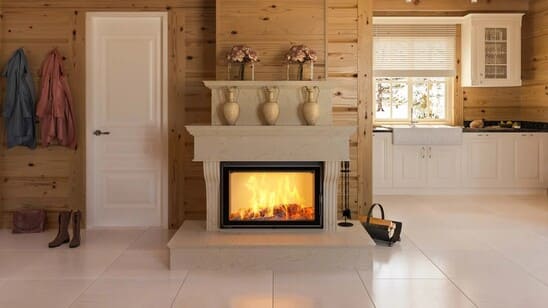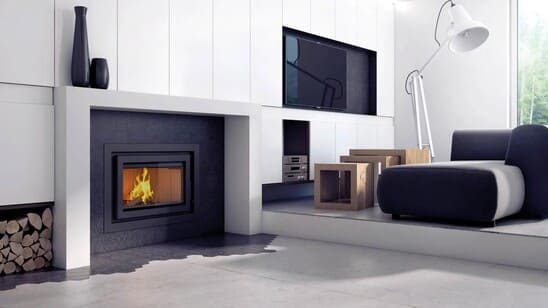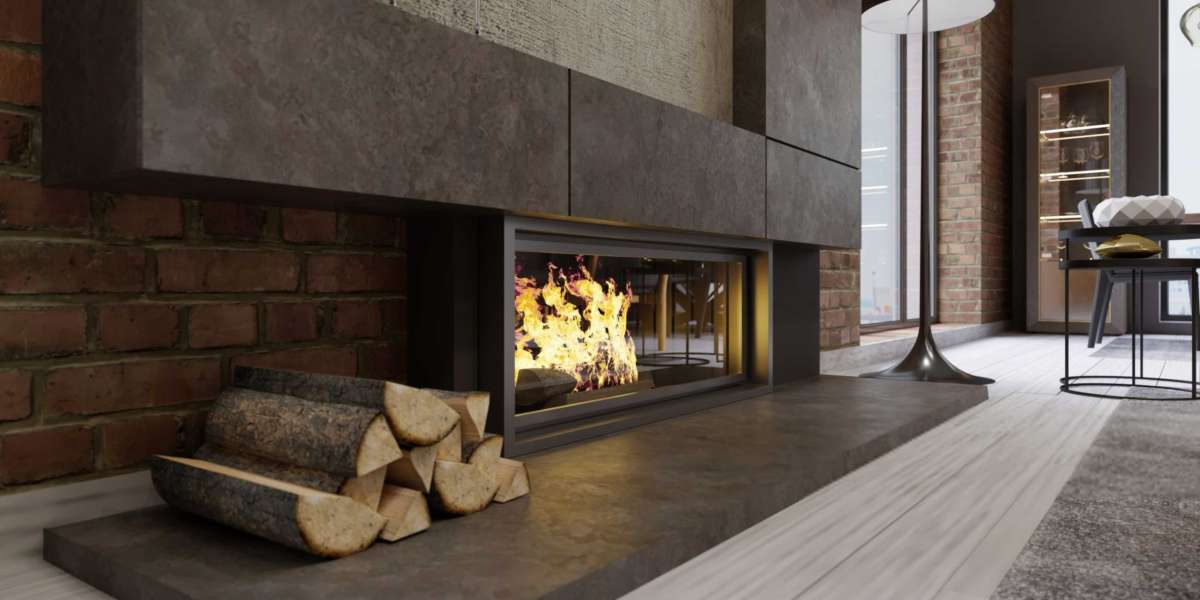Discover which types of wood provide the best efficiency, safety, and aesthetic appeal, how to determine the quality of firewood, and which wood species are most effective for heating. We’ll also cover the best practices for storing firewood both outdoors and indoors to maintain its properties and ensure easy access when needed.
The combination of a fireplace with the right power and quality firewood are essential elements for comfort, warmth, and ambiance in your home. While the technical specifications of the heating appliance are often clear, the choice of fuel can be more complicated. Do you need special firewood for your fireplace, or can you burn any type of wood? Are there modern alternatives to traditional firewood?
In this article, we’ll examine the best firewood for home fireplaces, how to store it, and the proper way to stack logs for an efficient, long-lasting fire.

Why Using the Right Firewood is Crucial for Heating
The performance of your fireplace—its efficiency, heat output, and safety—depends heavily on the quality of firewood. Even a high-end fireplace won't work effectively if you use subpar fuel. The burning temperature in fireplaces ranges from 450°C to 1000°C, while wood starts to ignite and smolder at around 300°C. Failing to follow best practices for firewood can lead to several issues.
Safety: Poor-quality firewood can produce excessive smoke, harmful emissions, and even pose a fire hazard. It may take longer to ignite or burn too quickly, often producing dangerous sparks. This can result in soot build-up on the glass door, dirty chimneys, and unsafe burning conditions.
Fireplace Efficiency: Different wood species burn at different rates and have varying levels of density and resin. Some types of wood aren’t recommended for fireplaces, so it's important to check your heating device’s specifications to find out what works best. This is particularly important if your fireplace is part of a central heating or hot water system for your home.
Aesthetic Appeal: Whether you have an open or closed fireplace, the live flame is often a centerpiece of the room. To enjoy the crackle of wood, soft warmth, and pleasant aroma, you need high-quality firewood that burns beautifully and efficiently.
How to Determine Firewood Quality
The quality of firewood, or its suitability for a particular fireplace, can be assessed based on several factors: wood type, heat output, drying time, storage conditions, log size, moisture content, and whether any additives or impurities are present. While some qualities can be visually checked, it’s also essential to buy from a trusted supplier.

Heat Output of Different Wood Types
One of the most important factors is the calorific value, which refers to the amount of heat generated and the burn duration. This is closely related to wood density: the denser the wood, the higher the heat output. Dense hardwoods such as oak, hornbeam, maple, and ash have high calorific values, while lighter woods like linden, aspen, alder, pine, and poplar burn less efficiently.
For example, oak has a calorific value of 1600–2400 kcal per cubic meter or around 2900 kWh. Based on this, the heat output percentage is calculated, showing how much heat the wood releases into the environment. Hornbeam and maple have the highest heat output at 85%, oak at 75%, birch at 68%, aspen at 51%, and poplar at 39%.
Moisture Content in Firewood
The moisture content of wood is expressed as a percentage and refers to the amount of water relative to the total weight of the wood. The more moisture in the wood, the worse it burns, as energy is wasted on evaporating the water rather than producing heat.
The ideal moisture level for firewood used in home fireplaces is 20% or less. This level is typical for properly harvested and seasoned wood that has been dried for at least six months, though a year and a half is preferable.
Optimal Firewood Size for a Fireplace
The best fire comes from logs that are consistent in size, typically 7–9 cm in diameter and about two-thirds or three-quarters the length of the fireplace’s opening.
Uniform logs burn evenly, producing maximum heat and minimal smoke, with no excessive soot. Poor-quality wood, or using waste materials like branches or bark, can result in excessive ash and clog the fireplace, potentially leading to chimney fires.
Best Wood Species for a Fireplace
For solid fuel fireplaces, hardwoods are the best choice. Woods such as oak, alder, and birch have dense structures that allow them to burn slowly and efficiently, with minimal resin and soot.
Oak burns the longest and is considered one of the best woods for fireplaces due to its high heat output. It has a heavy, dense structure, and the logs burn slowly, releasing a pleasant aroma. Oak coals also retain heat for a long time, making them an ideal addition to cheaper firewood.
Alder logs are aesthetically pleasing, often featuring a variety of colors on the cut surface. Properly dried alder logs store well and burn efficiently, producing little smoke and a bright flame.
Birch has a high heat output and burns thoroughly, leaving minimal ash. However, it requires a lot of air to burn efficiently; otherwise, tar may build up in the fireplace.

Compressed Firewood (Briquettes): Made from pressed wood or other materials like peat or coal, briquettes burn much longer and hotter than traditional firewood, with no sparks. They are easy to store and transport.
Woods to Avoid in Fireplaces
Avoid burning wet firewood as it wastes energy, produces excessive smoke, and leads to condensation in the combustion chamber, which quickly dirties the fireplace.
Additionally, coniferous woods like pine should not be used in fireplaces due to their high resin content, which creates soot and unpleasant smoke. Fast-burning, low-heat woods like willow and poplar are also poor choices for home fireplaces.
How to Properly Stack Firewood in the Fireplace
The arrangement of firewood in the fireplace plays a critical role in achieving a strong, safe fire and maximizing fuel efficiency.
First Fire: After a long period of inactivity, lay two or three large logs at the bottom of the firebox, followed by smaller logs laid perpendicular to the layer below. Top with kindling and a firestarter cube, ensuring enough space between the logs for air circulation. Allow the first fire to burn completely before adding more logs.
Best Practices for Firewood Storage
Firewood is not only a fuel source but can also enhance the aesthetic of your fireplace area. Indoors, stylish log holders complement the room’s decor while ensuring safety.
For outdoor storage, the best option is a roofed shelter that allows for ventilation while protecting the logs from rain. Alternatively, logs can be stacked against the house with a gap for airflow or stored on elevated shelves to protect them from moisture.

Key Tips for Choosing and Storing Firewood
For efficient home heating, choose hardwoods like oak, hornbeam, maple, or birch. Ensure logs are dry and free of impurities, and consider using briquettes for a long-lasting fire. Indoors, store firewood on decorative racks, and outdoors, stack it in a ventilated, protected area. Thoughtfully arranged firewood storage adds both functionality and style to your home.








